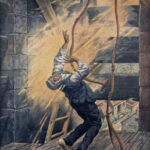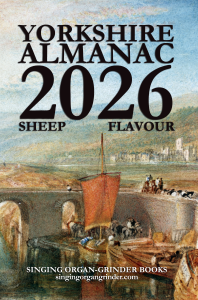28 December 1872: The tower of St Peter’s, Earlsheaton (Dewsbury), rings a true peal of Kent treble bob major (16,608 changes) in 9 hours 50 minutes, setting a new national record
Henry Thomas Ellacombe. 1873. The Church Bells of Somerset. Exeter: William Pollard. Get it:
.Excerpt
The following are the names and ages, with the stations of the performers: William Preston, 61, Earlsheaton, treble; Frank Bailey, 22, Batley Carr, 2; Seth Senior, 43, Earlsheaton, 3; John Henry Dixon, 20, Batley Carr, 4; James Idle, 45, Dewsbury, 5; Charles Senior, 38, Earlsheaton, 6; John Garforth, 24, Dewsbury, 7; Charles Alfred Fox, 33, Dewsbury, tenor. The first half of the peal was conducted by Mr Preston, who, from his long experience as a ringer, was eminently qualified for the position, and the latter half was entrusted to Mr Fox, whose ability for such an undertaking is well known, as he has accomplished that most critical tax on the mind of a conductor, namely, the calling of Mr Holt’s one part peal of grandsire triples, which contains 150 calls. It is probable that a long time will elapse before this feat is surpassed, as at present this is the longest length that has been composed in this system, although the author of the peal, Mr T. Day, of Birmingham, has devoted more than thirty years to the mathematical investigation of the permutations of this variety of treble bob major. As this meritorious composition has been brought about by the use of legitimate fourth-place bobs only, we have much pleasure in bringing it before our readers, and give it by the course ends, as follows: 237,546. Out, one fifth and one at home. 357,624. One the middle and in. 675,432. In and out, and one fifth. 763,452. Out, one the wrong, and two at home. 654,327. Fourths and in twice, fourths and out, one fifth, one wrong and one at home. 625,347. Two the middle, and one at home. 235,647. One the middle and out. 362,457. Out. 453,627. Out and two the wrong. 756,324. Out and fourths twice, and one fifth. 273,456. Two the middle, out and fourths, fourths and out, and two the wrong. 743,256. Two the middle, in and out, two fifths, and one at home. 467,235. Out and one fifth. 567,243. One the middle and in, and one the wrong. 236,457. In and out. 342,567. Out. There was a large gathering of ringers from all parts of the county, this event having caused considerable sensation among the members of the ringing community, and the truth of the peal was attested at various stages of its progress.
Comment
Comment
Clifford Allbutt in 1923 in The Cambridge Review:
On prize competition days Church Street, Dewsbury, a fairly wide street, used to be packed with listeners, and very critical listeners they were. Almost everyone had note-book in hand to mark errors in the peal, and few escaped their vigilance. … It was curious, and not without historical causes, that the towers were regarded by the ringers as a domain separate from the church, and the tenor kept the keys. At Dewsbury a barrel of beer was on tap in the chamber; and for a ringer to stray into church must have seemed like a transgression of the etiquette of his calling (Rolleston 1929).
Something to say? Get in touch
Original
At St. Peter’s Church, Earlsheaton, near Dewsbury, in Yorkshire, a company of ringers, one man only to each bell, on Saturday, December 28th, 1872, rang a true peal of Kent treble bob major, consisting of the astonishing number of 16,608 changes, which exceeds any previous performance by 768 changes. The time was returned in round numbers as 9 hours 50 minutes, the bells having struck off into changes at 4 minutes past 8 in the morning, and coming home at 6 minutes to 6 in the evening, and as at intervals during the day the ringing was returned as slightly over 28 changes to the minute, this time gives exactly 28¼ per minute. The striking was good throughout the day, and when well into the third part of the peal was such that it was hard to realise that the men had then been ringing for seven hours.
When the time drew nigh that it was calculated would bring the ringing to a conclusion a large crowd had gathered around the church, and when the bells came round a hearty cheer was given, and the ringers on issuing from the tower received quite an ovation.
The following are the names and ages, with the stations of the performers:- William Preston, 61, Earlsheaton, treble; Frank Bailey, 22, Batley Carr, 2; Seth Senior, 43, Earlsheaton, 3; John Henry Dixon, 20, Batley Carr, 4; James Idle, 45, Dewsbury, 5; Charles Senior, 38, Earlsheaton, 6; John Garforth, 24, Dewsbury, 7; Charles Alfred Fox, 33, Dewsbury, tenor.
This peal of bells, of which the tenor weighs 14 cwt., was cast by Messrs. Mears, of Whitechapel. The first half of the peal was conducted by Mr. Preston, who, from his long experience as a ringer, was eminently qualified for the position, and the latter half was entrusted to Mr. Fox, whose ability for such an undertaking is well known, as he has accomplished that most critical tax on the mind of a conductor, namely, the calling of Mr. Holt’s one part peal of grandsire triples, which contains 150 calls.
It is probable that a long time will elapse before this feat is surpassed, as at present this is the longest length that has been composed in this system, although the author of the peal, Mr. T. Day, of Birmingham, has devoted more than thirty years to the mathematical investigation of the permutations of this variety of treble bob major. As this meritorious composition has been brought about by the use of legitimate fourth-place bobs only, we have much pleasure in bringing it before our readers, and give it by the course ends, as follows:- 237,546. Out, one fifth and one at home. 357,624. One the middle and in. 675,432. In and out, and one fifth. 763,452. Out, one the wrong, and two at home. 654,327. Fourths and in twice, fourths and out, one fifth, one wrong and one at home. 625,347. Two the middle, and one at home. 235,647. One the middle and out. 362,457. Out. 453,627. Out and two the wrong. 756,324. Out and fourths twice, and one fifth. 273,456. Two the middle, out and fourths, fourths and out, and two the wrong. 743,256. Two the middle, in and out, two fifths, and one at home. 467,235. Out and one fifth. 567,243. One the middle and in, and one the wrong. 236,457. In and out. 342,567. Out.
The above part twice repeated makes the 16,608 changes, there being 51 courses and 189 calls. There was a large gathering of ringers from all parts of the county, this event having caused considerable sensation amongst the members of the ringing community, and the truth of the peal was attested at various stages of its progress.-Local Paper.
590 words.
Similar
 17 November 1812: A doggerel inscription at St. George’s, Doncaster, commemorates two sons of ringing master Robert Smith, one of whom died by his father’s bells
17 November 1812: A doggerel inscription at St. George’s, Doncaster, commemorates two sons of ringing master Robert Smith, one of whom died by his father’s bells 7 November 1920: In a guest sermon in the parish church where his father had officiated, Clifford Allbutt evokes the village of Dewsbury in the 1840s
7 November 1920: In a guest sermon in the parish church where his father had officiated, Clifford Allbutt evokes the village of Dewsbury in the 1840sSearch
Donate
Music & books
Place-People-Play: Childcare (and the Kazookestra) on the Headingley/Weetwood borders next to Meanwood Park.
Music from and about Yorkshire by Leeds's Singing Organ-Grinder.


 Bluesky
Bluesky Extwitter
Extwitter